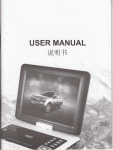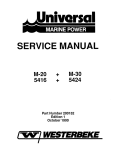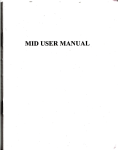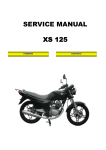Download White 1866 Instruction manual
Transcript
_______ INSTRUCTION MANUAL FOR 1 SEWING MACHINE ZA• / • WHITE • Call Toll Free 800-331-3164 www.whitesewing.com 1 I _________________ _________________ POLARIZED PLUGS CAUTION This product is equipped with a polarized alternatir current line plug (a plug having one blade wider th the other). This plug will fit into the power outlet on one way. This is a safety feature. If you are unable insert the plug fully into the outlet, try reversing the piLi If the plug should still fail to fit, contact an eiectrici to replace the obsolete outlet. Do not defeat the safe purpose of the polarized plug. WHITE SEWING MACHINE COMPANY Record in space provided below the Serial No. and Model No. of this appliance. The Serial No. is located on Bed Plate. The Model No. is located on Rating Plate. Serial No. Model No. Retain these numbers for future reference. iMPORTANT SAFETY INSTRUCTIONS basic safety precautions should always be When using an electrical appliance, folowed, including the following: Read all instructions before using (this sewing machine) ric shock: To reduce the risk of elect ER NG DA in. Always unplug this d plugge when ded unatten left be never An appliance should using and before cleaning. appliance from the electric outlet immediately after same type rated 15 watts. with Always unplug before relamping, Replace bulb WARNING To reduce the risk of burns, fire, electric shock, or injury to persons: case, and the Operate sewing machine only when mounted in sewing machine table, tions. like. See the installation instruc atention is necessary when this appliance 1. Do not allow to be used as a toy. Close is used by or near children. as described in this manual. Use only 2. Use this appliance only for its intended use acturer as contained in this manual. attachments recommended by the manuf ed cord or plug, if it is not working damag a it has if 3. Never operate this appliance or dropped into water, Return the, properly, if it has been dropped or damaged, center for examination, repair. service or appliance to the nearest authorized dealer ent, electncal or mechanical adjustm air openings blocked, iaeo ventilation open 4. Never operate the appliance with any free from the accumulation of :nt, ings of the sewing machine and foot controller dust, and loose cloth. ocening. 5. Never drop or insert any ooject into any 6. Do not use outdoors. ts are being used or wnere oxygen is 7. Do not operate where aerosol (spray) produc being administered. (0’) position, then ‘emove plug from 8. To disconnect, turn all controls to the off outlet. , grasp the plug, not the Cord. 9. Do not unplug by pulling on cord. To unplug l care is recuired around the sewing 10. Keeo fingers away from all moving parts. Specia machine needle. wrong plate can cause the needle to break. ii. Always use the proper needle plate. The 12. Do riot use bent needles. it to stitching. It may deflect the needle causing 13. Do not pull or push fabric while break. any adjustments in the needle area, Unplug the sewing machine when making , threading bobbin, or changing needle ng changi , such as threading needle presser foot, etc. the electrical outlet when removing covers, 15. Always unplug sewing machine from user servicing adiustments mentioned in the other any lubricating, or when making instruction manual. 14. SAVE THESE INSTRUCTIONS CONTENTS Name of Parts . 1 & 2 Accessories Before sewing (Power supply and Sewinct arrpl 4 Take out extension table free arm sewing Winding the bobbin 5 .6 . Removing bobbin case and bobbin 7 lnsertng bobbin into bobbin case 7 inserting bobbin case no shuttle, race 8 g Threading upper thread & Twin needle threading Drawing up bobbn thread 10 Changing sewing directions 11 Adjusting thread tension 12 Regulating the presser foot pressure 13 Drop feed 14 Chaiigtrg needle 15 Fabric, Thread, Needle table Sewing pastern selector) and ooeration table To start sewing 7 To finith seam 18 19 Straight siitch 19 Zigzag sewing Overcasting 20 . . . 2C Stretch stitch 21 & 2 Blind stitch . Button sewing Binding . 2. . Zipper sewing Button hole sewing Hemming Twin Needle Embroidery 2 2 2 Quilter Seam guide Maintenance (Cleaning and oilingl Checking Performance Problems WHAT TO DO 2. NAME OF PARTS (FRONT VIEW) / flEZ 11 0 Pattern selector dial 2 Take up ever 3 Tread tension dial 4 Tread guide for upper 1 threading 5 Presser foot 6 Shuttle cover 7 Handle 8 Spoolpir 9 Top cover 10 Stitch length dial 11 Reverse button Face cover 12 —1— / p.,) x 02 0 CD 0 C) C) Cu > Cu CD CD 0 0 CD -ci CD CD C) V 3 C) CD CD z CD CD (DC CD :, w — 0 U) 0 V CD a- C 0 CD DC 9. CD V V 0 V V CD CD z 02 0 0• 0’ CD 0 CD 0 0 0 Cr rTi m ACCESSOR I ES Bobbin Spool pin felt Button sew on foot Zipper foot Cording foot 1/4 inch piecing foot Machine oil Buttonhole cutter Zigzag foot (On machine) ,1 / 4, ‘Straight stitch foot Blind stitch foot Gathering foot Narrow hem foot Screw driver —3— I/ Buttonhole foot Needles #11 #14 BEFORE SEWING 1. Fit the machine p’ug nto the machine. 2. Plug the machine to the power supply. 3. Sewing speed can be varied by the speed controller. 1. Remove or install lamp from inside of face cover. 2. Open face cover in direction of arrow. 3. Remove lamp by unscrewing it counter clockwise. 4. Install a new bulb by screwrig it in clockwise. 15W 120V, 5. Use only a (Max) “Hi-Light” brand re placement sewing machine Available from your lamp. Riccar stockist. Important: When leaving the machine unattended, servicing, changing lamps or removing covers, disconnect from the supply by removing plug from the socket outlet. —4— E REMOVING EXTENSION TABL 4 ed use To convert the machine from flat-b ex the ve to free-arm use simply remo tension table as shown. FREE-ARM SEWING 1. Especially useful when sewing sleeves, pants leg, tubular fabrics etc more easily. 2. To sew tubular just slip the sleeve or pants leg on the free arm as shown above. 3. This sewing machine can be used as a flat bed machine, .1 but easily converts to free arm machine by removing the extension table. —5— I I / WINDING THE BOBBIN 1 Release stop motion kn 2. Thread as shown. 3. Place bobbin onto spin and hand-wind thread or bobbin in an anti-clockw direction for 5 or 6 turs (When bobbin is filled re-tight stop motion knob) 4iobbin winder spindle., 4. Push bobbin winder spindle against stopper, in directioti of arrow, and depress foot pedal. 5. When bobbin winding is comrn pleted return spindle to its original position. Note: If the bobbin winding should be uneven (it is factory set) the thread guide can be raised or lowered to achieve the correct winding. Remove the top cover and adjust with a suitable tool. 8— REMOVING BOBBIN CASE AND BOBBIN b. Ic to is, 1. Raise needle to its highest position and open the shuttle race cover. 2. hinged latch of and pull bob case bobbin of machine. out bin case Open 3. Release the latch and bob bin will fall out easily, INSERTING BOBBIN INTO BOBBIN CASE 1. Pull off 5cm of thread from bobbin and insert it into bobbin case as shown. 2. Guide the end of thread into slot. Tension spring 3. Pull into slot and under tension spring and draw out about 10 cm of thr —7--. / INSERTING BOBBIN CASE INTO SHUTTLE RACE Hinged latch 1. Ensure needle is at its highest position. Pulling thread to the front, open the latch of bobbin case and hold it. 2. Holding latch open, place bobbin case onto centre pin in shuttle and release latch. —8— THREADING UPPER THREAD ) Thread the machine from A to G as illustrated. A. Through the thread guide. B. Between the tension discs. C. Up and into the tension spring. D. Into the thread take-up ever from right to left. E. Down behind the thread guide. F. Behind the needle clamp thread guide. G. Through the needle from front to backFig. 1 & 2 also illustrates threading for twin needle sewing \k \ / ) ;/ (see page 27) F G —9— J DRAWING UP BOBBIN THREAD 1. Hold upper thread with left hand, turn the hand wheel slowly towards you until the needle goes down and comes Then stop the hand up. wheel when the takeup lever is at its highest position. Lighiiy draw up the upper thread will be brought up in a loop. 4 2. Pull out both threads and place them together under presser foot to the rear of machine. —10— CHA1JGING SEWING DIRECTION S 1. Lower needle down into fabri c and raise presser foot, pivot the fabric arouqd the needle to change direction as desired. L _ // 4 2. Put down presser foot and start to sew. I I —11— ADJUSTING UPPER THREAD TENSLON It is only normally necessary to adjust the upper thread tension to achieve the correct balance between the upper and lower threads. The higher the number on the dial the greater the tension. S Correct Incorrect Inside of fabric thread EUPPer Fabric Upper thread Bobbin thread THREAD LOWER ADJUSTING TENSION Lower thread tension can be adjusted by turning the screw on the bobbin case slightly to the right (clock-wise) to increase tension, (Anti-clockwise) to the left to decrease tension. As a general guide only, the user can achieve the correct tension for normal sewing, by carefully suspending the wound bobbin in its case by the thread. If the bobbin and case immediately fall to the ground, the tension is too loose and should be increased. The correct tension is obtained when a slight jerk of the thread causes the bobbin to drop a short distance only. If this action does not move the bobbin the tension is too tight and should be loosened until the desired effect is achieved. —12— increase Decrease REGULATING THE PRESSER FOOT PRESSURE 1. Adjust lever to desired pressure. For light fabrics use 3, for medium fabrics use 12, for heavy fabrics use 1. 2. Insufficient pressure may cause poor feeding, skipped stitches, or difficulty in guiding the fabric. 3. No. pressure adjustment is required when darning or sewing freehand em brodery. DROP FEED A Push feed lever down to drop feed below needle plate for darning, embroidery, and button sewing. B. Push feed lever up to raise feed above needle plate for normal Sewing. — 13— CHANGING NEEDLE 1. Raise needle ar to ts nichest position. 2 Loosen needle c:arnp screw and remove old needle. 3. With the flat side of the needle facing away from you, insen needle as tr up as it will go. 4 Tighten the needle clamp screw securely —14— FABRIC THREAD NEEDLE GUIDE As a general rule use shorter stitch lengths on finer fabrics and longer stitch lengths with heavier fabrics, finer thread and needles with finer fabrics and heavier thread and needles with heevier fabrics. Use special ‘ball point’ or stretch’ needles on difficult stretchy fabrics. 15— 6 : 2 Freehand Embroidery Twin Needle Button Hole Straight Stretch Stitch Slant Overedge except ii .c-_J I1 II Pttem buIioflhoe [1 Three step-Zigzag Stitch Blind Hem Zig-Zag Straight Stitch qwa - I 21 1 311 ?c< Stitch Inqth Not Necessary Pese, foot SEWING (PATTERN SELECTOR) AND OPERATION TABL E ropf,s TO START SEWING Imoortant Hints 1. Raise the take•up ever to its highest position wher starting and stopping sewing. 2. Hold both threads about 10 cms to the rear of machine for the first two to three stitches. 3. Sufficient fabric should be placed under needle before low ering presser foot. 4. Depress foot/Speed control and start to sew. 5. Test the machine stitches on a scrap of fabric you plan to use, adjusting the machine for me length of stitc h and tension suitable to you r fabric. Attention 1. 2. 3. When turrting the hand wheel manually, always turn it tow ard you. Guide the cloth gently with you r hand. To prevent breaking needle alw ays stop with the needle out of the fabric. I -17W / TO FINISH SEAM 4 1 Sew to the edge of seam. for 2.Push the reverse button and sew in reverse about 3-4 cms. 3iRaise need’e to its highest position. rear of 4.Lift presser loot and pullut the fabric to machine. 5.Cut threads as shown on the thread cutter. Thread — 18— STRAIGHT STITCH 1. This type of stitching is the one used most frequently. 2. The zigzag presser foot can be used for both straight and zigzag sewing. 3. For sewing light fabric, use smaller stitch size and left needle position. (Refer to page 16 for dial setting). ZIGZAG SEWING Pattern selector position. EE Zig-zag stitching is a general purpose stitch. Satin stitching is a “closed up”, very short stitch length, and can be used for sewing initials, patterns, applique, etc. —19— / ‘I OVERCASTiNG Use these stitches for oversewing rough edges. STRAIGHT STRETCH STJTCH III III Use this stitch with knitted.tricct or other stretchy fabrics. The stitch enables your seam to stretch with out breaking the thread. Ii is also a very strong straight stitch for areas under stress. — 20 — ______ BLIND STITCH 1. Fold fabric as shown. /p 2. To finish seam as shown. — / 21 — P°itiOfl Needle is not piercing edge of fold at all, Needle is pierces edge of fold too much, EL (A) (B) Correct seam —22— BUTTON SEWING (Use drop teed see page 13) I .Lcwer drop feed. . 2.Piace buffoh presser foot in position and attach firmly lower presser foot. 3.Place button between presser foot and fabric and the needle enters 4.Manually turn hand wheel towards you ensuring that into both holes of button without obstruction. (Increase or decrease width setting). 5.Sew about 7 stitches. 6,Pull both threads to the underside and tie together. BINDING To sew fabrics edge to edge select the multi zig-zag stitch. — - . . —. .-. /1 23 — ZIPPER SEWING ‘ .. S. Select straight stftch. 1. Zipper foot is designed to \ sew close to a raised edge preventing sewing on zipper 2. Place zipper foot in position and attach firmly 3, Fold the fabric about 2 cm and place fabric under foot 1. To sew the left side of zipper set ihe zipper foot on the right side of the needle. 2. To sew the right side of zipper set the zipper foot on the left side of the needle. sew as illustrated. —24 — BUTTON HOLE SEWING Select stitch length dial in area Indicated. Pattern selector dial Settirgs Steps I E 1. Set dial to “i” position. 2. Sew left side. 3. Raise the needle 4. Set dial to “2” position. 5. Sew 5-6 stitches. 6. Raise the needle 1 1 — I [ — .___.J 7, Set dial to “3” position. 8. Sew right side. 9. Raise the needle 10. Set dial to “4” position. 1 1, Sew 5-6 stitches. 12. Raise the needle I L Before sewing fit button-hole foot as shown, Cut buttonhole along centre with cutter as shown. — 25 — . - HEMMING (optional) 3mm 1mmj ‘1 20mm 1. Raise the foot and the needle to its highest position. Replace the foot with the hemmer foot. 2. Fold over the fabric edge by about 3mm and place it under the foot. Secure the folded edge with a few stitches. Take out the workpiece and draw the hem into the hemmer foot by pulling the threads. 3. Lower the foot and sew the hem. 4. During sewing, fold the fabric to the left a little and allow it to run into the hemmer foot. 5. Make sure that the fabric does not move under the right half of the foot. The fabric must be fed into the scroll of the hemmer sufficiently so that the workpiece edge runs freely through the groove under the foot. Only suitable materials can be used and some practice may be necessary to acheive best results. — 26 — 1’iJIN NEEDLE (optional) I J Thread mhine as for normal sewing passing both threads through the same procedure: NB. Sewing width should not exce ed the third widest stitch width, exceedin g this will result in breaking of need les. EMBROIDERY (Use feed see page 13) Lower feed dog and move hoop ed fabric slowly drop — 27 — to form the desired effect. QUILTER I %•% - 1. Insert supporter of quilter. 2. Move quilter and adjust stitch &stance. SEAM GUIDE 1. Use seam guide when sewing a long seam of regular distance from edge of materal. 2. Set guide in hoie on bed, at right of needle plate, and adjust distance. 3. Run machire with edge of material toucning guide. Position cloth guide at an angle to rew a curved seam. — 28 — ___ MAINTENANCE (CLEANING AND OILING) Raise needle to its highest position. Take out bobbin case. Turn latch knob A as illustrated. Take off shuttle race cover. Take out shuttle hook. 6. Clean and oil shuttle race and hook, then replace in the reverse order. I A C Cleaning shuttle race (A) Latch knob (B> Shuttle race cover (C> Shuttle hook ‘ Open face cover and oil points md cated. Cleaning feed dog — 29 — 0 C.) Puckering Machine Jamming Knocking Noise Breadktn Bobbin Thread Breaking Upper Thread Breaking Needle Fabric not moving PROBLEM Feed dog down. Machine not moving. Stitch length dial in 0 position. -. — — — — — — — — — — — — -- — — — — Incorrect using fabric, needle, and thread. Tension too tight. Sewing foot pressure too strong. Dust and thread in shuttle. No oil. Tight bobbin thread tension. Incorrect setting of needle. Improper threading. Dust and thread in shuttle. Needle bent. Nicks or burrs on shuttle. I ight upper thread tension. Improper threading. Light pressure on presser foot. Incorrect setting of needle. Needle bent. Pullencj fabric. —Incorrect using needle, thread and fabric. Incorrect position of zigzag width dial. — — — PROBABLE CAUSE — — Reset. Regulating sewing foot pressure Correct using fabric, needle and thread. Clean shuttle. Need oil. Loosen bobbin thread tension. Reset needle. Rethread machine. Clean shuttle. completely. Moving to correct position. Rethread machine. Loosen upper thread tension. Replace new needle. Replace shuttle, or polish off burrs Reset needle. Replace new needle. Do not pull fabric. Correct using needle, thread, and fabric. Raise feed dog. Moving stop motion. Moving dial to 1.4. Increase pressure on presser foot. — — — — — — - — — — — — — — - — — — — CORRECTION T TO DO CHECKING PERFORMANCE PROBLEMS WHA







































